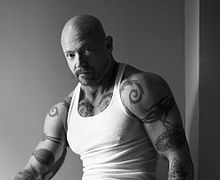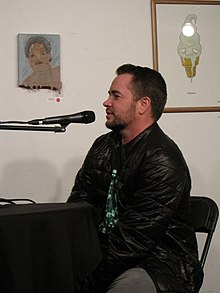Trans man

| Part of a series on |
| Transgender topics |
|---|
|
|
| Part of a series on |
| Boys and men |
|---|
 |
A trans man is a man who was assigned female at birth. The label of transgender man is not always interchangeable with that of transsexual man, although the two labels are often used in this way. Transgender is an umbrella term that includes different types of gender variant people (including transsexual people). Trans men have a male gender identity, and many trans men choose to undergo surgical or hormonal transition, or both (see sex reassignment therapy), to alter their appearance in a way that aligns with their gender identity or alleviates gender dysphoria.[1]
Although the literature indicates that most trans men identify as heterosexual (meaning they are sexually attracted to women),[2][3] trans men, like cisgender men, can have any sexual orientation or sexual identity, and some trans men might consider conventional sexual orientation labels inadequate or inapplicable to them, in which case they may elect to use labels like queer.[4]
Terminology




The umbrella term trans[a] is a shortening of both transgender and transsexual, and describes anyone whose gender identity does not align with their assigned sex. Trans men who transition are commonly referred to as female-to-male (FTM or F2M).[5]
The term transsexual originated in the medical and psychological communities, and is generally considered a subset of transgender, although the two are not always interchangeable. It predominantly describes people with medically diagnosed gender dysphoria, and who desire to permanently transition to the opposite sex via sex reassignment therapy. Many trans people prefer the labels transgender or trans, considering them more inclusive and less stigmatizing.[6][7] However, others, such as Buck Angel, reject the label of transgender.[8][9] The GLAAD media reference guide advises against describing people as transsexual, except for individuals who explicitly identify as such.[10]
Transmasculine (sometimes clipped to transmasc) is a broader term for all trans individuals with predominantly masculine identities or gender expression, and includes trans men as well as non-binary people who were assigned female at birth and may have a identity that is partially masculine but not entirely male.[11][12]
The alternate spelling transman is sometimes used interchangeably. However, like transwoman, it is often associated with trans-exclusionary views which hold that trans men are distinct from men, and thus require a separate word to describe them.[13] For this reason many transgender people find the spelling offensive.[13]
Transitioning


Originally, the term trans men referred specifically to female-to-male transsexual people who underwent hormone replacement therapy (HRT) or sex reassignment surgery (SRS), or both. The definition of transition has broadened to include theories of psychological development or complementary methods of self-acceptance.[14][15] Many of those who identify as transgender may face gender dysphoria.
Transsexual and transgender men may seek medical interventions such as hormones and surgery to make their bodies as congruent as possible with their gender presentation. However, many transgender and transsexual men cannot afford or choose not to undergo surgery or hormone replacement therapy.
Many who have not undergone top surgery choose to bind their breasts. There are a few different methods of binding, including using sports bras and specially made binders (which can be vest-type, or wrap-around style). Tape or bandages are often depicted in popular culture.
Some trans men might also decide to pack, to create a phallic bulge in the crotch of clothing. However, this is not universal. Trans men who decide to pack may use anything from rolled up socks to specially made packers, which resemble a penis. Some packers are also created for trans men to be able to urinate through them (stand-to-pee, or STP, devices), or for sexual penetration or other sexual activity (known as "pack-and-play").
Transitioning might involve some or all of the following steps:[16][better source needed]
- Social transition: using a preferred name and pronouns, wearing clothing seen as gender appropriate, disclosure to family, friends and usually at the workplace/school.
- Sex reassignment therapy: hormone replacement therapy (HRT), and/or surgery (SRS)[17]
- Legal affirmation: name and (sometimes) sex marker correction in legal identification documents.[18][19]
Being socially accepted as male (sometimes known as passing) may be challenging for trans men who have not undergone HRT and/or surgery.[18][19] Some trans men may choose to present as female in certain social situations (e.g. at work).[18][19] After physical transition, trans men usually live full-time as male.[18][19] However, some transmasculine individuals might choose to use and engage their bodies to be pregnant, birth a baby, and breastfeed.[20][21]
Prevalence, identity and relationships
In the United States, the ratio of trans men within the general population is unclear, but estimates range between 1:2,000 and 1:100,000.[22][better source needed][23][24][better source needed] A U.S. Census Bureau study in 2015 suggests that there were around 58,000 name changes in census records consistent with female to male transitions although only 7,500 of these changed their sex coding as well.[25][failed verification]
In a study by Kara Devaney, entitled Transgender Research Literature Review, it is addressed that the term transgender encompasses a myriad of different and unique identities that do not follow the "normal" rules of gender. Miriam J. Abelson writes, "There is no question that trans men's experiences are men's experiences and give insight about men, masculinity, and gender inequality."[26]
Like cisgender men, trans men can have any sexual orientation or sexual identity, including heterosexual, gay, bisexual, and queer,[4] and some trans men consider conventional sexual orientation labels inadequate or inapplicable to them.[27] The literature commonly indicates that sexual attraction to those of their same gender (e.g., trans men liking men and trans women liking women) is considerably less common among trans men than among trans women; the vast majority of trans men are reported as heterosexual.[2][3] Surveys from the National Center for Transgender Equality show more variation in sexual orientation or sexual identity among trans men. In NCTE's 2015 Transgender Survey of respondents who identified as trans men, 23% identified as heterosexual or straight. The vast majority (65%) identified their sexual orientation or sexual identity as queer (24%), pansexual (17%), bisexual (12%), or gay/same-gender loving (12%).[28]
Some trans men date heterosexual women, while other trans men date queer-identified women; the latter might be because queer-identified women are less invested in the gender and sexual anatomy of a person when it comes to selecting an intimate partner.[3] It is also common for trans men to have histories with the lesbian community or to feel that they identify better with that community because of its wide acceptance of gender variance, with a number of trans men having identified as lesbian (often as a "butch lesbian") before realizing that they are instead transgender.[2][3][29]
Trans men have less success integrating socially within cisgender gay men's communities, which tend to be more body-focused, especially in terms of being phallocentric.[3][30][31] Yitzchak et al. state that, as a result, they more commonly see gay trans men partnering with each other than with cisgender gay men.[3] There are, however, cases of women being likelier than men to thoroughly question trans men about their motivations for modifying their bodies.[30]
Some scholars argue against assumptions that trans men are predominantly heterosexual and usually have lesbian histories. In scholars Dan Irving and Rupert Raj's book Trans Activism in Canada, researchers state, "There is still a common misperception that trans men are largely heterosexual amongst those who conflate gender identity and sexual orientation. It is frequently assumed that trans men are exclusively attracted to women and have lesbian histories prior to transition." They add, "Recent data from the Trans PULSE project (Bauer, Redman, Bradley, & Scheim, 2013) challenge this assumption, with 63 percent of female-to-male spectrum trans people in Ontario reporting non-heterosexual identities and/or past-year sex with trans or non-trans men." They also argue that, based on some research, "many non-trans gay men have welcomed trans men into gay communities and have increasingly recognized trans men as potential sexual and romantic partners."[32]
Health
Trans men and transmasculine people often face difficulty and discrimination receiving medical treatment, due to both bias against assigned-female patients and against transgender people. In the 2015 U.S. Transgender Survey, 42% of 8,037 trans men reported negative experiences with healthcare providers.[28] There is a lack of credible research about how to provide adequate healthcare to transmasculine people undergoing medical transition, notably with doctors having difficulty diagnosing breast cancer in people who have undergone top surgery.[33] HIV infection between trans men and others is still increasing.[34]
Trans men may or may not be capable of menstruation and pregnancy depending on their individual circumstances.[35]: 1 [36] According to surveys compiled by Medicare for Australia, 75 male-identifying parents gave birth in Australia in 2016, and 40 in 2017.[37]
Discrimination
Transgender men can face discrimination as a result of their status as trans men. Such discrimination may include sexual violence.[38]
See also
Notes
- ^ occasionally spelled trans*, using the asterisk (
*) as a wildcard character
References
- ^ Bariola, Emily; Lyons, Anthony; Leonard, William; Pitts, Marian; Badcock, Paul; Couch, Murray (October 2015). "Demographic and Psychosocial Factors Associated With Psychological Distress and Resilience Among Transgender Individuals". American Journal of Public Health. 105 (10): 2108–2116. doi:10.2105/AJPH.2015.302763. PMC 4566567. PMID 26270284.
- ^ a b c Shankle, Michael (2013). The Handbook of Lesbian, Gay, Bisexual, and Transgender Public Health: A Practitioner's Guide to Service. Routledge. p. 175. ISBN 978-1-136-57355-2. Retrieved 10 January 2016.
- ^ a b c d e f Binik, Yitzchak M.; Hall, Kathryn S. K. (2014). Principles and Practice of Sex Therapy, Fifth Edition. Guilford Publications. p. 252. ISBN 978-1-4625-1389-5. Retrieved 10 January 2016.
- ^ a b Bockting, Walter; Benner, Autumn; Coleman, Eli (28 March 2009). "Gay and Bisexual Identity Development Among Female-to-Male Transsexuals in North America: Emergence of a Transgender Sexuality". Archives of Sexual Behavior. 38 (5): 688–701. doi:10.1007/s10508-009-9489-3. PMID 19330439. S2CID 27207925.
- ^ Swann, William B.; Gómez, Ángel; Vázquez, Alexandra; Guillamón, Antonio; Segovia, Santiago; Carillo, Beatriz (10 February 2015). "Fusion with the Cross-Gender Group Predicts Genital Sex Reassignment Surgery". Archives of Sexual Behavior. 44 (5): 1313–1318. doi:10.1007/s10508-014-0470-4. PMID 25666854. S2CID 3261825.
- ^ Polly, Ryan; Nicole, Julie (March 2011). "Understanding transsexual patients: culturally sensitive care in emergency nursing practice". Advanced Emergency Nursing Journal. 33 (1): 55–64. doi:10.1097/TME.0b013e3182080ef4. PMID 21317698. S2CID 2481961. Archived from the original on 11 March 2022. Retrieved 14 May 2022.
The use of terminology by transsexual individuals to self-identify varies. As aforementioned, many transsexual individuals prefer the term transgender, or simply trans, as it is more inclusive and carries fewer stigmas. There are some transsexual individuals, however, who reject the term transgender; these individuals view transsexualism as a treatable congenital condition. Following medical and/or surgical transition, they live within the binary as either a man or a woman and may not disclose their transition history.
- ^ A Swenson, Medical Care of the Transgender Patient, in Family Medicine (2014): "While some transsexual people still prefer to use the term to describe themselves, many transgender people prefer the term transgender to transsexual."
- ^ "Transsexualism". Gender Centre. March 2014. Archived from the original on 4 March 2016. Retrieved 5 July 2016.
Transsexualism is often included within the broader term 'transgender', which is generally considered an umbrella term for people who do not conform to typically accepted gender roles for the sex they were assigned at birth. The term 'transgender' is a word employed by activists to encompass as many groups of gender diverse people as possible. However, many of these groups individually don't identify with the term. Many health clinics and services set up to serve gender variant communities employ the term, however most of the people using these services again don't identify with this term. The rejection of this political category by those that it is designed to cover clearly illustrates the difference between self-identification and categories that are imposed by observers to understand other people.
- ^ @BuckAngel (9 April 2019). "Transsexual is my identity and where I came from. [...] Transgender does not represent me" (Tweet) – via Twitter.
- ^ "GLAAD Media Reference Guide – Transgender Terms". GLAAD. 22 February 2022. Retrieved 4 June 2022.
- ^ MacDonald, Trevor; Noel-Weiss, Joy; West, Diana; Walks, Michelle; Biener, MaryLynne; Kibbe, Alanna; Myler, Elizabeth (16 May 2016). "Transmasculine individuals' experiences with lactation, chestfeeding, and gender identity: a qualitative study". BMC Pregnancy and Childbirth. 16 (1): 106. doi:10.1186/s12884-016-0907-y. PMC 4867534. PMID 27183978.
{{cite journal}}: CS1 maint: unflagged free DOI (link) - ^ "Definition of transmasculine". Dictionary.com. Retrieved 8 September 2016.
- ^ a b German Lopez, Why you should always use "transgender" instead of "transgendered", Vox, February 18, 2015
- ^ "Hudson's Guide: FTM Basics: Terminology". Hudson's FTM Resource Guide. Retrieved 22 February 2015.
- ^ "Glossary of Terms and Usage". Hebrew Union College – Jewish Institute of Religion. Archived from the original on 19 May 2014. Retrieved 22 February 2015.
- ^ "What is transition?". FTM Australia. 14 April 2007. Archived from the original on 25 July 2008. Retrieved 4 June 2022.
- ^ Meriggiola, Maria Cristina; Gava, Giulia (25 March 2015). "Endocrine care of transpeople part I. A review of cross-sex hormonal treatments, outcomes and adverse effects in transmen". Clinical Endocrinology. 83 (5). Wiley: 597–606. doi:10.1111/cen.12753. hdl:11585/541907. ISSN 0300-0664. PMID 25692791. S2CID 11480289.
- ^ a b c d Lev, Arlene Istar (2004). Transgender Emergence: Therapeutic Guidelines for Working with Gender-Variant People and their Families. The Haworth Clinical Practice Press. ISBN 978-0-7890-2117-5. OCLC 51342468.
- ^ a b c d Eno, Amanda S. (21 June 2013). "The Misconception of Sex in Title VII: Federal Courts Reevaluate Transsexual Employment Discrimination Claims". Tulsa Law Review. 43 (3): 765–792. ISSN 1942-986X.
- ^ MacDonald, Trevor; Noel-Weiss, Joy; West, Diana; Walks, Michelle; Biener, MaryLynne; Kibbe, Alanna; Myler, Elizabeth (16 May 2016). "Transmasculine individuals' experiences with lactation, chestfeeding, and gender identity: a qualitative study". BMC Pregnancy and Childbirth. 16 (1): 106. doi:10.1186/s12884-016-0907-y. PMC 4867534. PMID 27183978.
{{cite journal}}: CS1 maint: unflagged free DOI (link) - ^ Bonnington, Adam; Dianat, Shokoufeh; Kerns, Jennifer; Hastings, Jen; Hawkins, Mitzi; Haan, Gene De; Obedin-Maliver, Juno (1 August 2020). "Society of Family Planning clinical recommendations: Contraceptive counseling for transgender and gender diverse people who were female sex assigned at birth". Contraception. 102 (2). Elsevier BV: 70–82. doi:10.1016/j.contraception.2020.04.001. ISSN 0010-7824. PMID 32304766. S2CID 215819218.
- ^ Conway, Lynn (17 December 2002). "Estimating the Prevalence of Transsexualism".
- ^ Herman, Joanne (12 May 2006). "There are more of us than you think". The Advocate (LGBT magazine). Retrieved 22 February 2015.
- ^ Rohde, Maggi (1996). "FAQ - Transgenderism". The Alliance of Les-Bi-Gay-Transgender and Straight Ally Students, Michigan State University. Archived from the original on 20 May 2008. Retrieved 4 June 2022.
- ^ Cerf-Harris, Benjamin (4 May 2015). Likely Transgender Individuals in U.S. Federal Administrative Records and the 2010 Census (PDF) (Report). U.S. Census Bureau. Archived from the original (PDF) on 12 January 2017. Retrieved 4 June 2022.
- ^ Abelson, Miriam (17 October 2014). Men in Context: Transmasculinities and Transgender Experiences in Three US Regions (Thesis). hdl:1794/18512.
- ^ "Sexual Orientation and Gender Identity Definitions". Human Rights Campaign. Retrieved 4 June 2022.
- ^ a b James, Sandy E.; Herman, Jody L.; Rankin, Susan; Keisling, Mara; Mottet, Lisa; Anafi, Ma'ayan (December 2016). "The Report of the 2015 U.S. Transgender Survey" (PDF). Washington, DC: National Center for Transgender Equality. Archived (PDF) from the original on 30 May 2022. Retrieved 4 June 2022.
- ^ Haggerty, George; Zimmerman, Bonnie (2003). Encyclopedia of Lesbian and Gay Histories and Cultures. Taylor & Francis. p. 776. ISBN 978-1-135-57870-1. Retrieved 10 January 2016.
- ^ a b Schilt, Kristen (2010). Just One of the Guys?: Transgender Men and the Persistence of Gender Inequality. Chicago: University of Chicago Press. p. 153. ISBN 978-0-226-73807-9. OCLC 587209584. Retrieved 10 January 2016.
- ^ Sumerau, J E; Mathers, Lain (2019). America through Transgender Eyes. Lanham: Rowman & Littlefield. pp. 60–61. ISBN 978-1538122082. OCLC 1064762453.
- ^ Irving, Dan; Raj, Rupert (2014). Trans Activism in Canada: A Reader. Canadian Scholars' Press. p. 248. ISBN 978-1-55130-537-0. Retrieved 10 January 2016.
- ^ Patel, Jharna M.; Dolitsky, Shelley; Bachman, Gloria A.; Buckley de Meritens, Alexandre (20 August 2019). "Gynecologic cancer screening in the transgender male population and its current challenges". Maturitas. 129. Elsevier BV: 40–44. doi:10.1016/j.maturitas.2019.08.009. ISSN 0378-5122. PMID 31547911. S2CID 201958946.
- ^ Tang, Songyuan; Tang, Weiming; Meyers, Kathrine; Chan, Polin; Chen, Zhongdan; Tucker, Joseph D. (20 October 2016). "HIV epidemiology and responses among men who have sex with men and transgender individuals in China: a scoping review". BMC Infectious Diseases. 16 (1): 588. doi:10.1186/s12879-016-1904-5. PMC 5073436. PMID 27765021.
{{cite journal}}: CS1 maint: unflagged free DOI (link) - ^ Frank, S. E.; Dellaria, Jac (25 July 2020). "Navigating the Binary: A Visual Narrative of Trans and Genderqueer Menstruation". The Palgrave Handbook of Critical Menstruation Studies. Singapore: Springer Singapore. pp. 69–76. doi:10.1007/978-981-15-0614-7_7. ISBN 978-981-15-0613-0. PMID 33347161.
- ^ Obedin-Maliver, Juno; Makadon, Harvey J (28 October 2015). "Transgender men and pregnancy". Obstetric Medicine. 9 (1): 4–8. doi:10.1177/1753495X15612658. ISSN 1753-495X. PMC 4790470. PMID 27030799.
- ^ Hattenstone, Simon (20 April 2019). "The dad who gave birth: 'Being pregnant doesn't change me being a trans man'". The Guardian. Retrieved 4 June 2022.
- ^ Chonwilai, Sulaiporn (17 May 2016). "Trans community still faces violence". Bangkok Post. Retrieved 4 June 2022.
Further reading
- Becoming a Visible Man by Jamison Green
- Just Add Hormones: An Insider's Guide to the Transsexual Experience by Matt Kailey
- Transmen and FTMs: Identities, Bodies, Genders, and Sexualities by Jason Cromwell
- FTM: Female-to-Male Transsexuals in Society. by Aaron H. Devor
- Second Son: Transitioning Toward My Destiny, Love and Life by Ryan Sallans
External links
- Transman at Curlie
- Medical Therapy and Health Maintenance for Transgender Men: A Guide For Health Care Providers free ebook, ISBN 0-9773250-0-8
- TransGuys.com A magazine for trans men
- FTM International An organization serving the female-to-male trans community.
- Original Plumbing magazine Quarterly magazine with online component focusing on culture and diversity in the trans male community.
